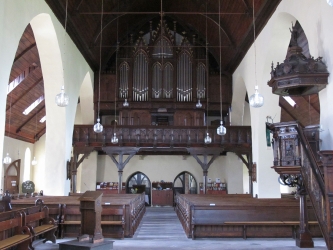Organ Art Media 1686/1720 Bosch F.C. Schnitger Organ Grote of Sint Nicolaas Kerk Vollenhove Overijssel The Netherlands
Achat immédiat: 304.00 CHF
Description
n 1686 Apollonius Bosch (~1620-1699) of Amsterdam placed an organ in the church consisting of a Hoofdwerk, a Rugwerk and pull-down pedals.
Frans Caspar Schnitger was born in 1695 and learned the organ building trade from his father Arp. In 1720 Frans Caspar was commissioned to rebuild the organ in Vollenhove. It is very often said, that Frans-Caspar Schnitger was still better than his father. This is not only due to the fame of his name, but also to his majestic organ in the Grote-of St. Michaelskerk in Zwolle and his famous rebuild of the Van Hagerbeer organ in the St. Laurenskerk in Alkmaar.
Schnitger placed a new wind chest in the Rugwerk and added new stops, reeds and labials to the organ. It's assumed, that he did tonal adaptations and extensions like in the Alkmaar organ later on.
In 1860 Jan van Loo from Zwolle/Overijssel added pedal towers on each side of the Hoofdwerk case with stops of such high quality, that one is not able to hear significant differences to genuine Schnitger ranks. He added six free pedal stops, all of which are still in the organ. As usual, several modifications were made in the 19th century.
It's a luck, that all front pipes (Prestant) are still original and mostly come from 1686. The Gebroeders Van Vulpen of Utrecht restored the organ in 1977 back to 1720 while maintaining the 1860 free pedal. All of the pipes had to be lengthened to the original pitch of a’ = 415. The organ was tuned to a Werckmeister I temperament.
The organ is especially famous for its warm Prestant sounds from 1686, the bright and clear church acoustics with about 4-5 s reverberation and the quality of the Schnitger reed stops as well as the added pedal ranks. The organ is also important for its original Cornet, one of the earliest examples of this stop in the north of the Netherlands. Cornet stops are normally not to be found in Schnitger organs.
Organ tuning: Werckmeister I temperament at a1=420Hz
Wind pressure: 68 mm
Manual compass: C - c3 (extd. version d3)
Pedal compass: C - d1 (extd. version f1)
Hoofdwerk
(b) - Prestant 8 VT
(f/b) - Bourdon 16 VT **/ Bourdon 8 VT bas, disc
(s) - Roerfluit 8 VT bas, disc *
(b) - Octaaf 4 VT
(v) - Fluit 4 VT bas, disc
(d) - Fluit 2 VT bas, disc
(b) - Octaaf 2 VT
(b) - Mixtuur 2-4 ST
(v) - Cimbel 4-6 ST
(s) - Trompet 8 VT bas, disc
(s) - Vox Humana 8 VT *
(b) - Cornet 4 ST
Tremulant
Rugpositief
(b) - Holpijp 8 VT
(b) - Prestant 4 VT
(b) - Fluit 4 VT
(v) - Nasard 3 VT
(s) - Octaaf 2 VT
(s) - Woudfluit 2 VT
(v) - Mixtuur 4 ST (Scherp)
(v) - Sexquialter 2 ST
(s) - Dulciaan 8 VT
Tremulant, Schuifkoppel: Rugwerk + Hoofdwerk
Pedaal
(l) - Subbas 16 VT
(l) - Prestant 8 VT
(l) - Holfluit 8 VT
(l) - Octaaf 4 VT
(l) - Trombone 8 VT
(l) - Bazuin 16 VT
Copling: Pedaal + Hoofdwerk, Pedaal + Rugwerk
Note:
b: Bosch (1686)
d: Duyschot (~1700)
s: Schnitger (1720)
f: Freytag (1808)
l: Van Loo (1860)
v: Van Vulpen (1977)
VT = voet (feet)
ST = sterk (strongth, number of ranks)
Scherp = Sharp
Schuifkoppel = shove coupler, by moving keyboard backwards
Extd. Version :
* Reconstructed 1720 state:
Roerfluit: Virtual copy from F. C. Schnitger organ Duurswoude/Frisland
Vox Humana: Virtual copy from F. C. Schnitger organ Duurswoude/Frisland
** Reconstructed 1808 state: Bourdon 16 VT
Vous souhaitez voir ce produit dans notre showroom?
Remplissez simplement ce formulaire et nous prendrons contact avec vous pour convenir d'un rendez-vous !






